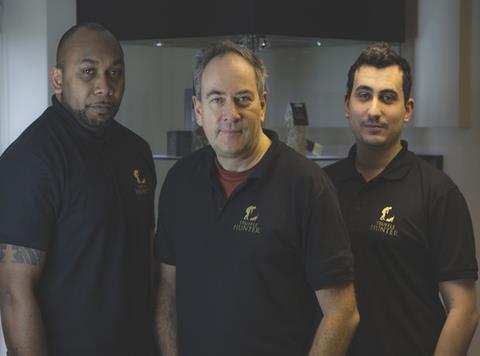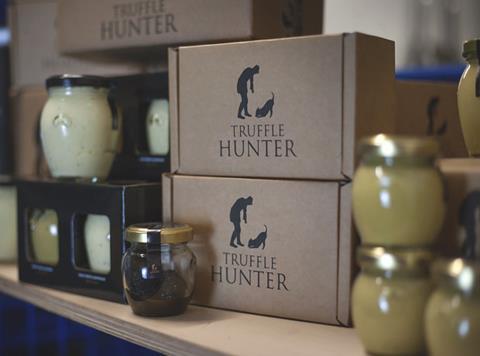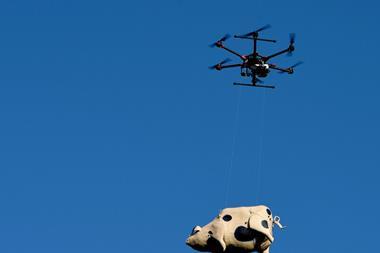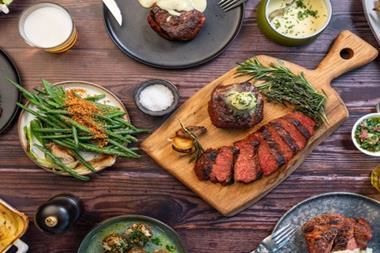Truffles have always enjoyed a recherché reputation. Not to be confused with the soft, buttery chocolates that share their name, the pungent truffle is part of the fungi family and grows 10 inches below ground on the roots of trees. Trained dogs are required to sniff it out.
Everyone used to use pigs, but they were clumsier. And greedier. And “quite aggressive” says Trufflehunter MD Nigel Whitehouse. “I’ve never been attacked by a truffle hunting pig, but I wouldn’t want to get a truffle off a sow in heat. Dogs just pinpoint them and dig. Then the hunter takes over.”
Today, Whitehouse has “hundreds” of truffle hunters operating across Europe, sending truffles back to Trufflehunter HQ, which nestles in a corner of the Cotswolds. But it all started back in 2008, while Whitehouse was living in the Sibillini Mountain region of central Italy, where one day he came across the “fascinating” sight of a market stall selling truffles.
“I was renovating an old house nearby and looking around for business opportunities,” he says. “Mainly I was intrigued by the price - ‘€200 for this little white truffle? You must be joking.’ But it was also the clandestine way they were traded, the secret locations where they grow, it was all just captivating. So I started dabbling.”
That meant sourcing product from local hunters and building a “very amateur” website to sell Italian truffles into the UK. “During that time I learned a lot about truffles and saw a real market opportunity. The way truffles were sold and marketed wasn’t being done very well. If you were ordering fresh truffles from Italy you wouldn’t know when they would turn up, or what the quality would be like. And if you wanted them in August, forget it, because Italy closes for a month.”

As well as starting to supply restaurants he “started thinking about retail. At the time you’d go into a deli and you might find something ugly and dusty at the back of the shelf for £15 with some Italian writing on it. I thought if I made a good-quality product at a reasonable price point, put English on there to tell people what it is and how to use it, then there would be a market for it. Our intention was to demystify the product.”
In October 2010, he moved back to the UK and set up in “half an industrial unit” with some “really basic bottling equipment”. He sunk £50,000 in to get going and turned over £125,000 in year one. Last year, sales hit £1.6m. “We are growing at 50% a year so next year I would expect to hit £2.5m,” he says.
As for profits, he says “costs are high as we are investing in our core infrastructure and staff but we are a profitable company, there is no question about that”.
Business is “50% direct sales online” and the other 50% “split evenly between foodservice and wholesale. We also sell direct to restaurant groups and larger food halls like Selfridges and Harrods. We also sell in Booths. It’s not a huge quantity but it’s reasonable, although it’s a step too far for the big four.”
Fresh figures
Some 20% of Trufflehunter’s sales are fresh truffles sourced from across Europe; 80% are jarred or bottle truffle products. One advantage is the shelf life of a fresh truffle is a week, and a product 18 months. But there are others. “If we get to the end of the week and any fresh truffles haven’t sold, they get turned into product. We never have to throw anything away because it’s approaching its sell-by date.”

Given the wholesale price of a fresh White Winter truffle hit £2,000 per kilo in 2016, that’s just as well (prices drop to £100 per kilo for the cheapest fresh Black Summer truffle). But there are also “much higher costs associated with fresh truffles, like shipping and wastage costs and labour costs for grading and washing. So you’re lucky to get 20% gross margin on fresh truffles. But you can double that margin on the products.”
As for the future, the business is ripe for expansion. “There is a lot more we can do in the UK, but there are also a huge amount of export opportunities we haven’t tapped yet. The US is obvious, we already do big business through Amazon, but also the whole of the Middle East, the Far East, China and Scandinavia. So the potential is huge.”



















No comments yet